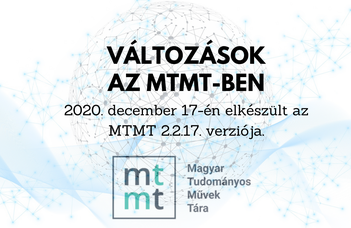Változások az MTMT-ben
2.2.17. verzió

2020. december 17-én elkészült az MTMT 2.2.17. verziója.
Az új verzió két jelentős változtatást tartalmaz:
-
ORCID azonosító megerősítése
-
Mi az ORCID?: az ORCID a szerző egyedi azonosítására alkalmas országtól függetlenül.
-
A megerősítés menete: A megerősítés vagy a felugró ablakból, vagy a Saját adatok menü Adataim szerkesztése alól (a form alján lévő gombbal) indítható el. A folyamat az ORCID honlapján folytatódik, s egy bejelentkezést vár a felhasználótól. A sikeres azonosítás után megjelenik egy oldal, ahol engedélyezni tudjuk az MTMT számára az eredmény átadását. Ehhez kattintsunk az „Authorize access” feliratú gombra. Ezzel visszalépünk az MTMT oldalra, ahol egy üzenet tájékoztat minket a sikeres megerősítésről.
-
Miért hasznos a hitelesített ORCID azonosító? Egyre gyakoribb, hogy a publikációban a szerzői név mellett feltüntetésre kerül az ORCID azonosító is. Ennek segítségével pl. automatikusan elvégezhetők szerzői hozzárendelések. Jelenleg az MTMT már képes az idéző import során az abban szereplő ORCID azonosítók alapján a szerzői hozzárendelés automatikus elvégzésére. Ehhez elengedhetetlen, hogy az MTMT-ben rögzített ORCID azonosítók megbízhatóak és egyediek legyenek. Ezt a célt szolgálja ez az eljárás.
-
- Az idézések és említések kezelésének változása
- A változás a többes idézést használó szerzőket érinti! (MTA II. osztály)
- Korábban a többes hivatkozásokat az idézéskapcsolatok többszörös felvitelével lehetett megvalósítani. Az idézés kapcsolat egyedi kell legyen, tehát egy idézett és egy idéző közlemény között ezentúl csak egy kapcsolat létezhet. Amennyiben valaki többes idézést kíván rögzíteni, azt az idézéskapcsolat-rekord „Hivatkozás előfordulások” mezőjében való felsorolással teheti meg. Ugyanitt kell rögzíteni a hivatkozás helyét, pontosító adatait.
- Az új verzió bevezetésével a korábbi említések, azaz többszörös idézéskapcsolatok automatikusan említésekké lesznek átalakítva a következő metódus szerint:
- Minden olyan többszörös idézéskapcsolat említésre lesz alakítva, ahol megkülönböztetésre alkalmas adat meg van adva, azaz oldalszám, jegyzetszám, kontextus valamelyike, mely különbözik a többitől.
- Amennyiben nincs megadva olyan adat, amely alapján a két idézéskapcsolat megkülönböztethető lenne, vagy a megadott adatok megegyeznek, úgy ezeket duplumnak tekintjük, s ezekből csak egy említés jön létre.
- A rendszer átalakítása miatt még előfordulhatnak hibák. Amennyiben ilyet tapasztalnak, kérjük jelezzék intézményi MTMT adminisztrátoruknak!
- Forrás és bővebb információk
Changes in MTMT
The MTMT version 2.2.17. was completed on December 17, 2020.
The new version includes two major changes:
- Confirming your ORCID identifier
- What is ORCID?: ORCID uniquely identifies the author, independent of his/her country.
- More information about the creation of ORCID (currently only in Hungarian)
- Confirmation process: The confirmation can be started either from the pop-up window or from the ‘Edit my own data’ menu in the ‘My Data’ menu (with the button at the bottom of the form). The process is continued on the ORCID website and a login from the user is expected. After successful identification, a page will appear where we can allow MTMT to pass the result. To do this, click on the button labeled ‘Authorize access’. This will take you back to the MTMT page, where a message will inform us of the successful confirmation.
- Why is a certified ORCID useful? It is becoming more and more common for the publication to include the ORCID in addition to the author's name. As an example, author assignments can be made automatically this way. Currently MTMT is already able to perform author assignments automatically based on the ORCIDs in the citation import. To do this, it is essential that the ORCIDs recorded in MTMT are reliable and unique. This procedure serves this purpose.
- Source and more information (only in Hungarian)
- New changes in the citation and reference treatment
- The change only affects authors who use multiple citations! (Class II of the Hungarian Academy of Sciences)
- Previously, multiple citations could be implemented by multiple citation links. The citation relation must be unique, so there can now be only one relation between a citation and a citation post. If someone wants to record multiple citations, they can do so by listing them in the ‘Mention’ field of the citation relationship record. The location of the reference and its clarifying data must be recorded there
- With the introduction of the new version, previous citations, that is, multiple citation relationships, are automatically converted to citations according to the following method:
- All multiple citation links will be converted to mentions where distinctive data is provided: one of the page numbers, note numbers, contexts different from the others.
- If no data is given that would make the two citation relationships distinctive, or the data provided are the same, they are considered duplicates and only one mention is made.
- Errors may still occur due to system redesign, so if you experience one, please report it to your institutional MTMT administrator!
- Source and more information (only in Hungarian)

